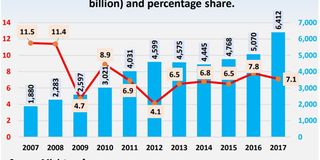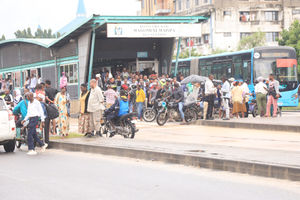Concern as manufacturing growth slows

What you need to know:
- The Gross Domestic Product (GDP) report published by the National Bureau of Statistics (NBS) this month says manufacturing grew by 7.1 per cent last year, lower than the 7.8 per cent recorded in 2016.
Dar es Salaam. Growth of Tanzania’s manufacturing sector is slowing down, making the country teeter towards the semi-industrialised, middle-income economy envisaged in the National Development Vision 2025.
The Gross Domestic Product (GDP) report published by the National Bureau of Statistics (NBS) this month says manufacturing grew by 7.1 per cent last year, lower than the 7.8 per cent recorded in 2016.
In 2007, the sector enjoyed the double-digit growth of 11.5 per cent.
According to the national accounts for 2017, the manufacturing-to-GDP share at 2007 constant prices was 7.4 per cent in 2016, lower than the 7.5 per cent recorded in 2010 and 2011.
At current market prices, the latest GDP report shows that manufacturing value increased to Sh6.41 trillion last year, from Sh5.07 trillion the year before. Its share-to-GDP also increased to 5.5 per cent last year, from 4.7 per cent in 2016.
GDP figures were, however, different from those from the National Accounts published by the same institution which indicated that the share of manufacturing at current prices was 5.1 per cent in 2016 – and 5.2 per cent in 2015.
This trend means that the share of manufacturing-to-GDP is still volatile.
It indeed was targeted to contribute at least ten per cent of the GDP. Some stakeholders believe that the manufacturing growth volatility results from “deprived business and market environments.”
The Repoa director of Strategic Research and senior Economics lecturer at Dar University, Dr Abel Kinyondo, says Tanzania must improve the manufacturing business environment.
“Tax reforms, assured availability of industrial inputs and reliable manpower will encourage investment in, and growth of, manufacturing,” he said – adding that a good market environment is a must, as is people’s enhanced purchasing power for manufactured products.
Noting that “investors in special export processing zones are routinely provided with good business environment,” Dr Kinyondo said this enables them to readily export their products.”
A former director of Policy and Advisory at the Confederation of Tanzania Industries (CTI), Mr Hussein Kamote, urged the government to review its industrial policies and regulatory frameworks so that, instead of just attracting investors, they also must enable domestic industries to perform well.
“The government must also research into why local manufacturers perform poorly,” he said, citing textiles industries which are either performing poor or have collapsed.
An Economics lecture at Dar es Salaam University, Professor Humphrey Moshi, said industrialization is not a few days’ process. It involves several stages of development.
“We can expect tangible growth in the manufacturing sector in the coming financial year – especially after the government revisited important aspects in the 2018/19 budget, including export and import tariffs, tax reforms and an increased agriculture budget,” the professor asserted.
For her part, the Economics Society of Tanzania (EST) chief executive officer, Dr Blandina Kilama, said improvements in transportation, information, marketing, monetary and human capital are needed – not forgetting farmers and other producers of raw materials.
“The government must create a good environment for farmers who are the main producers of raw materials by providing them with subsidies and a good market environment so that industries will have enough resources to operate with,” she said.




